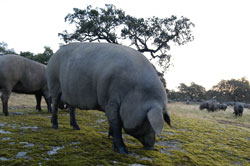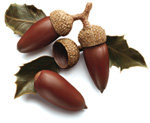 Often considered the world's finest ham, Jamon Iberico de Bellota is an exquisite type of cured ham produced only in Spain. Like the Jamon Iberico, it is made from an ancient breed of black-footed pigs found in the southern provinces of Spain and Portugal. However, unlike standard Iberico ham, the pigs used for Jamon Iberico de Bellota live a unique lifestyle roaming the oak forests of the Dehesa. Their primary diet consists of acorns, or bellota, which in combination with their active lifestyle, contributes a nutty, rich and delicious flavor to the resulting ham.
Often considered the world's finest ham, Jamon Iberico de Bellota is an exquisite type of cured ham produced only in Spain. Like the Jamon Iberico, it is made from an ancient breed of black-footed pigs found in the southern provinces of Spain and Portugal. However, unlike standard Iberico ham, the pigs used for Jamon Iberico de Bellota live a unique lifestyle roaming the oak forests of the Dehesa. Their primary diet consists of acorns, or bellota, which in combination with their active lifestyle, contributes a nutty, rich and delicious flavor to the resulting ham.
Bellota Ham verses other Spanish Jamon
Jamon Iberico de Bellota:
- Produced with at least 75% cerdo iberico breed pig, with its final diet based exclusively on acorns (bellota) and grasses contained in the Dehesa, an open-range forest, designated by the government. Bellota ham is noted for high levels of monounsaturated fat, in the form of oleic acid, which give it its trademark flavor and nutritional value. This distinctive characteristic is due to the antioxidant-rich acorns consumed by the pig during its final months foraging in the tree-laden meadows. The resulting ham is tested via gas chromatography to ensure that the levels of fatty acid meet the specifications for bellota grade ham. In addition, the regulated density can be as low as 1 pig per hectare, to ensure that the animals have enough access to exercise and acorns to produce their distinctive chemistry. Bellota grade jamones (hams) and paleta (shoulders) typically dry-cure for 24 to 36 months. This jamon is known as a luxury item and is best enjoyed as a tapa on its own.
Jamon Iberico de Recebo:
- Produced with at least 75% cerdo iberico breed pig, with the final diet based at least 85% on acorns and grasses found in the open-range dehesas and the remainder on commercial-grade feed. The density of pigs per hectare for this grade is slightly higher than bellota ham. Like bellota grade ham, the resulting meat products are evaluated based upon the levels of fatty acid. These jamones and paletas dry-cure for at least 24 months.
Jamon Iberico Cebo de Campo:
- Produced with at least 75% cerdo iberico breed pig, with the final diet based primarily on commercial-grade feed, but may include a limited diet of acorns and grasses. This is the most recent grade introduced to the official standards by Spain's Ministry of Agriculture, and the regulated density of pigs per hectare for this grade is 12. These jamones and paletas dry-cure for at least 24 months.
Jamon Iberico (or Jamon Iberico de Pienso):
- Produced with at least 75% cerdo iberico breed pig, with the final diet based on commercial-grade grain feed. These animals are generally kept pastured in a traditional barnyard environment and will have the highest permitted density of pigs per hectare.
Jamon Serrano:
- Spain's mountain ham, produced with with European white pigs. Its plump shape will resemble a guitar, unlike the more slender, violin-like shape of the Iberico jamon. It is most similar in texture and flavor to Italian prosciutto, yet it is a leaner meat cured without a moisture-retaining layer of fat. Although it can vary by production region, jamon serrano is typically cured with the simple ingredients of sea salt and dry mountain air. To qualify for the highest standard, it must weigh at least 14 pounds and been cured for at least nine months. It's mild flavor makes it versatile for a variety of Spanish tapas.
Physical Characteristics of Jamon de Bellota:
-
Appearance:
- Long shape with traditional V-cut pattern
- Trademark black hoof left in place to aid identification
- color ranging from pink to a purple-red
- well-marbled fat throughout the flesh
- the color of fat is a light pink or yellow
-
Taste:
- slightly sweet and salty with hint of roasted nut at room temperature
- aroma has subtle hint of dry nut
- texture is not fibrous
- pleasant tasting fat
The Cerdo Iberico Pig
 Bellota ham must be made with at least 75% pure cerdo iberico breed pig. This ancient Spanish breed, also known as pata negra, is distinguished by long, slender legs and snout and most prominently by its black hooves. These black hooves are typically left on the final ham or shoulder as a testament to its genetic authenticity. Cerdo iberico pigs can be black, red, spotted, or on occasion light skinned. They grow much faster and will generally become larger than the more familiar white/pink breed of Europe and North America. While some jamon labels, such as Cinco Jotas, use nothing less than pure 100% Iberian breed pigs, many use pigs with genetic blend of cerdo iberico and duroc to offer additional flavor. According to the The Spanish Ministry of Agriculture, there are also guidelines for the appellation of cerdo iberico:
Bellota ham must be made with at least 75% pure cerdo iberico breed pig. This ancient Spanish breed, also known as pata negra, is distinguished by long, slender legs and snout and most prominently by its black hooves. These black hooves are typically left on the final ham or shoulder as a testament to its genetic authenticity. Cerdo iberico pigs can be black, red, spotted, or on occasion light skinned. They grow much faster and will generally become larger than the more familiar white/pink breed of Europe and North America. While some jamon labels, such as Cinco Jotas, use nothing less than pure 100% Iberian breed pigs, many use pigs with genetic blend of cerdo iberico and duroc to offer additional flavor. According to the The Spanish Ministry of Agriculture, there are also guidelines for the appellation of cerdo iberico:
Iberico puro: pure cerdo iberico mother and father, registered in the studbook.
Iberico: mother of cerdo ibercio pig stock
Photo Credit: Cinco Jotas ~ Sanchez Romero Carvajal
The Dehesa
 Spain was once covered with magnificent prehistoric forests, but time and modernity has reduced these to a small number of controlled meadows. In order to create a self-sustaining protected environment, the oak trees in these remaining forests in the Extremadura were systematically thinned for the use of agriculture and ecological preservation for over 55 species. Pigs destined for bellota grade products are lucky enough to spend their remaining months in these lovely forests foraging freely for acorns, herbs and grasses. In return, they help preserve the Dehesa by nibbling away the undergrowth and by fertilizing the soil.
Spain was once covered with magnificent prehistoric forests, but time and modernity has reduced these to a small number of controlled meadows. In order to create a self-sustaining protected environment, the oak trees in these remaining forests in the Extremadura were systematically thinned for the use of agriculture and ecological preservation for over 55 species. Pigs destined for bellota grade products are lucky enough to spend their remaining months in these lovely forests foraging freely for acorns, herbs and grasses. In return, they help preserve the Dehesa by nibbling away the undergrowth and by fertilizing the soil.
Photo Credit: Cinco Jotas ~ Sanchez Romero Carvajal
The Curing Process
 Bellota hams are cured for a longer period than other Iberico hams, due to their extra fat and high levels of antioxidants (from the acorns). The tradition of curing, even in large quantities, is often the same as it was in Spain thousands of years ago. The hams are salted and cured for a period of 14 days. The higher (and cooler) the elevation, the less salt needed. The hams are then hung to dry in secaderos open to the mountain air and finally transferred to cool storage cellars known as bodegas. Over the course of this time,(which can last as long as four years) the fat drips off and the weight of the ham is reduced by half. In addition, seasonal temperature fluctuations cause chemical changes in the ham, which contribute much to its intense flavor. One of the most notable transformations occur in the properties of the remaining fat on the ham, in which the saturated fats become mono-unsaturated fats, which are healthier due to the high values of oleic acid - a benefit also found in olive oil.
Bellota hams are cured for a longer period than other Iberico hams, due to their extra fat and high levels of antioxidants (from the acorns). The tradition of curing, even in large quantities, is often the same as it was in Spain thousands of years ago. The hams are salted and cured for a period of 14 days. The higher (and cooler) the elevation, the less salt needed. The hams are then hung to dry in secaderos open to the mountain air and finally transferred to cool storage cellars known as bodegas. Over the course of this time,(which can last as long as four years) the fat drips off and the weight of the ham is reduced by half. In addition, seasonal temperature fluctuations cause chemical changes in the ham, which contribute much to its intense flavor. One of the most notable transformations occur in the properties of the remaining fat on the ham, in which the saturated fats become mono-unsaturated fats, which are healthier due to the high values of oleic acid - a benefit also found in olive oil.
Photo Credit: Cinco Jotas ~ Sanchez Romero Carvajal
Health Benefits of Jamon Iberico de Bellota
 Bellota-grade ham is considered highly nutritious, and is often recommended by Spanish doctors for patients with high cholesterol. The pig's acorn-laden diet produces meat high in oleic acid - the healthy fat that lowers "bad" cholesterol (LDL) and raises the "good" (HDL)! As the dry air of Spain does not require heavy salting to cure meats, bellota ham also has less sodium and retains many natural vitamins and minerals.
Bellota-grade ham is considered highly nutritious, and is often recommended by Spanish doctors for patients with high cholesterol. The pig's acorn-laden diet produces meat high in oleic acid - the healthy fat that lowers "bad" cholesterol (LDL) and raises the "good" (HDL)! As the dry air of Spain does not require heavy salting to cure meats, bellota ham also has less sodium and retains many natural vitamins and minerals.
Jabugo
 One Spanish town takes particular pride in its production of jamon iberico de bellota. Jabugo, a village set in the Aracena mountains of the Huelva province, has become so well-known for its production of top quality jamon that many today simply refer to bellota ham as "Jabugo." However, this term is often misleading, as only meat produced in Jabugo's singular climate and environmental conditions can meet the standard of Jabugo products.
One Spanish town takes particular pride in its production of jamon iberico de bellota. Jabugo, a village set in the Aracena mountains of the Huelva province, has become so well-known for its production of top quality jamon that many today simply refer to bellota ham as "Jabugo." However, this term is often misleading, as only meat produced in Jabugo's singular climate and environmental conditions can meet the standard of Jabugo products.
Photo Credit: Cinco Jotas ~ Sanchez Romero Carvajal


